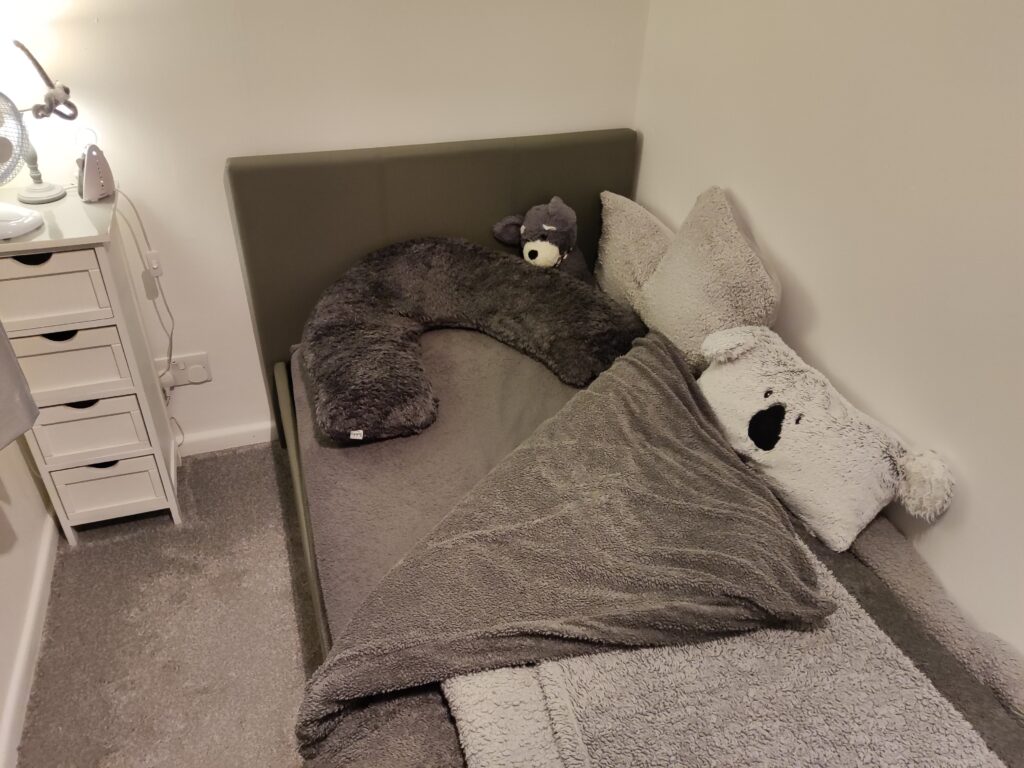Knowing which bed you should choose for your autistic child is a key part of the sleep puzzle.
In the below article we’ll explain from experience which types of bed may be right for your child.
Beds for autistic kids
Creating a comfortable, safe, and secure sleeping environment for children with autism is paramount for their well-being and crucially a good nights sleep.
Children on the autism spectrum may have specific sensory needs, preferences, and challenges.
All of these that can significantly affect their sleep quality.
Here are some critical considerations and advice for parents looking to select the right bed for their autistic child.
Sensory considerations
Autism affects kids differently, with many experiencing heightened or reduced sensitivity to sensory inputs.
Before choosing a bed, observe and understand your child’s sensory preferences:
Textures: Some children might prefer certain fabrics that are soft, smooth, or have a particular weave.
Weight: Weighted blankets can provide a sense of security for some children with autism, helping them to calm down and sleep better.
Compression sheets have been a hit for many parents in our position.
Enclosure: Beds that offer a sense of enclosure, like tent beds or canopy beds, can help some children feel safer and more secure.
Safety and comfort
Safety Rails: For children who move a lot in their sleep, beds with safety rails can prevent falls. Ensure the rails are tall enough and the gaps are small to avoid entrapment.
Mattress Choice: Choose a mattress that supports your child’s body well. Memory foam can be a good option for children who need extra pressure relief.
Adjustability: Consider beds that are low to the ground to minimize injury from falls. Adjustable beds that can change position might also be beneficial for children with specific physical needs.

Durability and cleaning!
Let’s be honest, perhaps not the most exciting considerations but worth baring in mind.
Children with autism may have behaviours that can put more wear and tear on furniture.
Durable Materials: Look for beds made from durable materials that can withstand jumping, bumping, and other intensive use.
Ease of Cleaning: Beds that are easy to clean and maintain, with washable covers and water-resistant materials, can help manage accidents and spills.
Personal preferences
Incorporating your child’s personal preferences and interests can make the bed feel more comforting and inviting.
Theme and Colour: A bed in the colour or theme of something your child loves (e.g., space, animals, a favorite colour) can make bedtime more appealing.
Interactive Elements: Some beds come with built-in shelves or cubbies which can be useful for children who like to have their favourite items or sensory tools close by.
Trial and error
Selecting the right bed may require some trial and error.
Flexibility: Be prepared to make adjustments based on your child’s feedback and comfort levels.
Advice: Consulting with occupational therapists or other professionals who understand your child’s specific needs can provide valuable insights into the best sleeping solutions.
Summary – Choosing the right bed for an autistic child
Choosing a bed for an autistic child involves more than just aesthetics or price.
It requires a thoughtful consideration of the child’s unique needs, sensory preferences, and safety.
By prioritising comfort, safety, and personalisation, parents can create a sleep environment that supports their child’s well-being, leading to better sleep for the child and, consequently, the entire family!
Remember, the goal is to provide a safe haven where your child can relax and recharge, ready for the adventures of the next day.
Any tips or ideas?
We would love to hear from you if you have got any techniques or ideas for our readers to try.
Be sure to leave a comment if any of the above has helped or if you have any ideas we can add to this article.
Also be sure to search for any other articles you might find helpful.
Try for example searching below for topics like ‘meltdown’ or ‘communication’.

